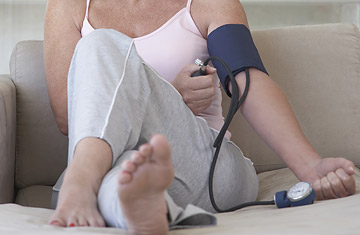
When it comes to your health, being your own doctor usually isn't the smartest idea. But new evidence suggests that if you're one of the 1.5 billion people around the world with high blood pressure, you may be better off taking control of your own treatment than relying on a doctor.
Researchers at Group Health in Seattle, a nonprofit health care system that helps patients find appropriate care and coverage, found that patients with high blood pressure who were given access to a pharmacist and a Web-based self-monitoring system were able to control their hypertension better than patients who underwent traditional physician care, which involved several office visits per year. The self-check group was able to drop nearly 30 points off its readings on average over the year-long study period.
"Controlling hypertension is particularly suited for this kind of application of technology," says Dr. Daniel Jones, president of the American Heart Association and dean of the school of medicine at University of Mississippi Medical Center. "We have been using the standard approach for many years with disappointing results. Only about one-third of patients with high blood pressure have it controlled properly, and among those on treatment, only half are able to control their blood pressure."
Among the more than 700 patients in the study, 258 were put into a standard physician-care group, with regular office visits. The remainder were divided into two self-care groups: in the first, patients had access to their electronic medical records and were instructed to measure their own blood pressure two to three times each week; patients then sent the results to their physician, who recorded the readings in files the patients could review. In the other group, patients performed the same self-measurements, but were also provided access to a pharmacist who evaluated their readings and helped patients adjust medication dosages as necessary. At the end of a year, twice as many people in the home-care-only group lowered their blood pressure to under 140/90 mmHg (the clinical cut-off for high blood pressure), compared with the standard-care group. But the patients with access to a pharmacist saw the most dramatic decline in blood pressure — a nearly 28-point lower measurement in the top number, or systolic reading, compared with the traditionally treated group. "We were surprised that the Web-based model had such a good effect, especially in those with more difficult-to-control hypertension," says lead author Dr. Beverly Green. "These people were three times more likely to get their blood pressure under control with the help of the pharmacist than those in the standard-care group."
It may be that hypertension is a particularly good condition to treat with home-based strategies, say both Jones and Green. Like weight-loss support groups and exercise programs, pharmacist-assisted self-monitoring keeps patients motivated and compliant with their treatment — and, in some cases, may prevent the disease from becoming serious enough to require pharmaceutical treatment. Most physicians also acknowledge that more frequent monitoring is likely more accurate: doctors take only one or two blood pressure measurements a year, when patients come into the office, but those readings can be influenced by a patient's stress or tenseness in the doctor's office (the "white coat syndrome"), and blood pressure can vary from day to day or even during a single day, depending on what a person is experiencing. "If somebody comes in and tells me they rushed in because they were late, and their blood pressure is high, I give them a pass," says Dr. Eric Peterson at Duke University. Individual readings taken a few months apart can also be difficult to interpret, he says. But measurements that patients take at home, several times a week, offer a more accurate picture of where their blood pressure stands.
Still, it will take some fundamental changes in the way health care is delivered before the study findings can be instituted. For one thing, relying on Web-based systems could potentially widen the gap in access to health care between wealthier patients and those who can't afford computers. In addition, not every physician will want to monitor e-mails or conduct virtual exams without being reimbursed for his or her time and expertise. "Our overall health-care system is poorly designed for prevention," says Jones. "We need to look again at the whole system to find effective and efficient ways to deliver this kind of management for chronic risk factors like hypertension."
